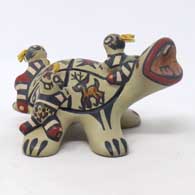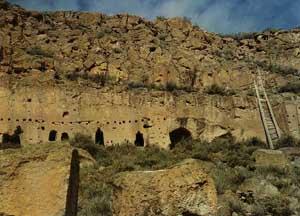
Margaret and Luther Gutierrez
Santa Clara

Margaret Gutierrez was born in 1936 and passed on in 2018. She and her brother, Luther, were a team of Santa Clara potters. Their parents were Lela and Van Gutierrez Luther was born in 1911, began making pottery around 1935. He made pots almost until the day he passed on in 1987.
From 1956 to about 1966, Luther worked with Lela after Van died, then worked with Margaret after Lela died. The signature dates on their pottery are like this:
- Lela/Luther signature: 1956-1966
- Margaret/Luther signature: 1966-1987
- Margaret/Pauline: 1987-1988
- Margaret alone: 1988-2018
Margaret and Luther began collaborating in the early 1960s but that ended when Luther passed on. After that, Margaret worked with Luther's daughter, Pauline. Shortly after that, Pauline died, so Margaret began working with Pauline's daughter, Stephanie.
Margaret and Luther continued and expanded on a tradition begun by their parents. In the early days of their collaboration, they were producing polychrome jars, bowls and wedding vases, often decorated with avanyu, clouds, rain, sky bands and lightning bolts in bright, traditional Santa Clara color combinations. Then Luther began searching out new colors of clay and they developed their own unique color palette. In the 1970s they switched it up and began producing polychrome figurines of various animals and other creatures, painted with the unique color palette they had become famous for.
They were participants in the 1974 Seven Families in Pueblo Pottery exhibit at the Maxwell Museum of Anthropology in Albuquerque. In 1976 they were honored with a show at the Popovi Da Studio of Indian Arts at San Ildefonso Pueblo. In 1985, along with Margaret Tafoya and others, they were participants in a show at the Sid Deutsch Gallery in New York City.
Margaret, by herself, won a First Place ribbon for a painted wedding vase at the Santa Fe Indian Market in 1975. She participated in Santa Fe Indian Market every year from 1975 to 1998. She was also a participant in the Eight Northern Pueblos Arts and Crafts Show from 1995 to 1998. Margaret and Luther may not have won a lot of awards during their career together but they did make a lot of people smile with the sheer whimsicality of many of their pieces.
100 West San Francisco Street, Santa Fe, New Mexico 87501
(505) 986-1234 - www.andreafisherpottery.com - All Rights Reserved

Santa Clara Pueblo

Ruins at Puye Cliffs, Santa Clara Pueblo
Santa Clara Pueblo straddles the Rio Grande about 25 miles north of Santa Fe. Of all the pueblos, Santa Clara has the largest number of potters.
The ancestral roots of the Santa Clara people have been traced to ancient pueblos in the Mesa Verde region in southwestern Colorado. When that area began to get dry between about 1100 and 1300 CE, some of the people migrated eastward, then south into the Chama River Valley where they constructed several pueblos over the years. One was Poshuouinge, built about 3 miles south of what is now Abiquiu on the edge of the Jemez foothills above the Chama River. Eventually reaching two and three stories high, and with up to 700 rooms on the ground floor, Poshuouinge was occupied from about 1375 CE to about 1475. Drought then again forced the people to move, some of them going to the area of Puye (on the eastern slopes of the Pajarito Plateau of the Jemez Mountains) and others downstream to Ohkay Owingeh (San Juan Pueblo, along the Rio Grande). Beginning around 1580 CE, drought forced the residents of the Puye area to relocate closer to the Rio Grande and they founded what we now know as Santa Clara Pueblo on the west bank of the river, with San Juan Pueblo to the north and San Ildefonso Pueblo to the south.
In 1598 the seat of Spanish government was established at Yunque, near San Juan Pueblo. The Spanish proceeded to antagonize the Puebloans so badly that that government was moved to Santa Fe in 1610, for their own safety.
Spanish colonists brought the first missionaries to Santa Clara in 1598. Among the many things they forced on the people, those missionaries forced the construction of the first mission church around 1622. However, like the other pueblos, the Santa Clarans chafed under the weight of Spanish rule. As a result, they were in the forefront of the Pueblo Revolt of 1680. One Santa Clara resident, a mixed black and Tewa man named Domingo Naranjo, was one of the rebellion's ringleaders. However, the pueblo unity that allowed them to chase the Spanish out fell apart shortly after their success, especially after Popé died.
When Don Diego de Vargas came back to the area in 1694, he found most of the Santa Clarans on top of nearby Black Mesa (with the people of San Ildefonso). A six-month siege didn't subdue them so finally, the two sides negotiated a treaty and the people returned to their pueblos. However, successive invasions and occupations by northern Europeans took their toll on all the tribes over the next 250 years. Then the swine flu pandemic in 1918 almost wiped them out.
Today, Santa Clara Pueblo is home to as many as 2,600 people and they comprise probably the largest per capita number of artists of any North American tribe (estimates of the number of potters run as high as 1-in-4 residents).
Today's pottery from Santa Clara is typically either black or red. It is usually highly polished and designs might be deeply carved or etched ("sgraffito") into the pot's surface. The water serpent, (avanyu), is a very common traditional design motif on Santa Clara pottery. Another motif comes from the legend that a bear helped the people find water during a drought. The bear paw has appeared on much of their pottery ever since.
Santa Clara has received a lot of distinction because of the evolving artistry the potters have brought to their craft. Not only did this pueblo produce excellent black and redware, several notable innovations helped move pottery from the realm of utilitarian vessels into the domain of art. Different styles of polychrome redware emerged in the 1920s-1930s. In the early 1960s experiments with stone inlay, incising and double firing began. Modern potters have also extended the tradition with unusual shapes, slips and designs, illustrating what one Santa Clara potter said: "At Santa Clara, being non-traditional is the tradition." (This refers strictly to artistic expression; the method of creating pottery remains traditional).
Santa Clara Pueblo is home to a number of famous pottery families: Tafoya, Baca, Gutierrez, Naranjo, Suazo, Chavarria, Garcia, Vigil, and Tapia - to name a few.
100 West San Francisco Street, Santa Fe, New Mexico 87501
(505) 986-1234 - www.andreafisherpottery.com - All Rights Reserved

Gutierrez Family Tree
Disclaimer: This "family tree" is a best effort on our part to determine who the potters are in this family and arrange them in a generational order. The general information available is questionable so we have tried to show each of these diagrams to living members of each family to get their input and approval, too. This diagram is subject to change should we get better info.
- Jose Domingo Gutierrez (1844-before 1931) and Tonita Gutierrez (1859-aft 1934)
- Lela (1895-1966) & Van (Evangelio) Gutierrez (1885-1956)
- Luther Gutierrez (1911-1987) & Lupita Naranjo
- Paul & Dorothy (Navajo) Gutierrez
- Gary Gutierrez
- Paul Gutierrez Jr. (1966-)
- Pauline Gutierrez Naranjo (1931-)
- Stephanie Naranjo (1960-)
- Paul & Dorothy (Navajo) Gutierrez
- Margaret Rose Gutierrez (1936-2018)
- Luther Gutierrez (1911-1987) & Lupita Naranjo
- Severa Gutierrez Tafoya (1890-1973) and Cleto Tafoya
- Angela Tafoya Baca (1927-2014) & Antonio Baca
- Alvin Baca (1966-)
- David Baca (1951-)
- Epimenia (Mela) Tafoya (1920-1962) & Robert Nichols
- Robert Cleto Nichols (1961-) & Miana Pablito (Zuni)
- Lydia Tafoya (1923-1975) & Santiago Garcia (San Juan/Ohkay Owingeh)
- Greg Garcia (1961-2010)
- Tina Garcia (1957-2005)
- Virginia Garcia (1963-)
- Maria (Mary Agnes) Tafoya (1925-1983) & Mosimino Tafoya
- Gwen Tafoya
- Wanda Tafoya (1950-)
- Eric Tafoya (1969-)
- Tonita (1930-) & Paul Tafoya
- Paul Speckled Rock (1952-2017)
- Adam Speckled Rock (1972-)
- Kenneth Tafoya (1953-)
- Ray Tafoya (1956-1995) & Emily (Suazo) Tafoya
- Jennifer (Tafoya) Moquino (1977-) & Michael Moquino
- Paul Speckled Rock (1952-2017)
- Angela Tafoya Baca (1927-2014) & Antonio Baca
Some of the above info is drawn from Pueblo Indian Pottery, 750 Artist Biographies, by Gregory Schaaf, © 2000, Center for Indigenous Arts & Studies. Other info is derived from personal contacts with family members and through interminable searches of the Internet.
(505) 986-1234 - www.andreafisherpottery.com - All Rights Reserved


